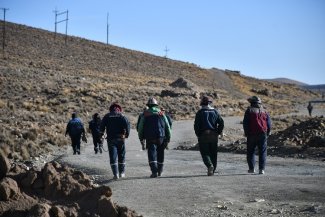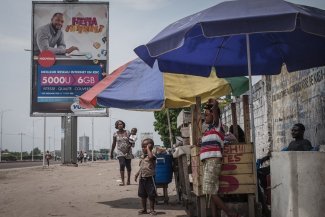A training day organised by the “Escravo, nem pensar!” (Slavery, No Way!) programme for teachers and social workers on 7 April 2016 in São Paulo.
The Brazilian media regularly covers the “rescue” of workers.
At the end of March, four Chinese workers were discovered in a bakery in Rio de Janeiro, where they were working without pay and without the right to leave the premises.
That same week, the “mobile inspection teams” of the Labour Ministry in the state of Pará, in the Amazon region, freed 26 people from slave labour on two plantations. Their employers had been withholding the workers’ wages for several months and were lodging them in appalling conditions, without basic sanitation or drinking water.
Each worker is now entitled to claim compensation for non-pecuniary damages of up to R$30,000 (US$8200).
Every year, some 2,000 workers are “rescued” in this way from their ruthless employers.For decades, the profile of the exploited worker was that of an older, dark-skinned man, performing arduous manual labour on agricultural plantations, like in the days of slavery, although it was abolished in 1888. Over recent years, it has taken on a new face, on construction sites and garment workshops in towns and cities, and affects immigrant populations such as Bolivians, Haitians, Peruvians and the Chinese.
In 2013, inspections carried out on large public works (São Paulo International Airport, World Cup) sent the statistics through the roof in urban areas.
A crime against human dignity
In Brazil, forced labour is classed as a crime under Article 149 of the Penal Code and is punishable by two to eight years in prison. It is, of course, characterised by constraint, but also deprivation of the right to come and go (as a result of threats or debt), excessive working hours that place the worker’s health and safety at risk, deprivation of rest periods (daily or weekly), excessive pay deductions (to cover lodging, transport, equipment, etc.) and, finally, degrading conditions (ill-treatment, insalubrious accommodation, absence of medical assistance, lack of drinking water, food, sanitary facilities, etc.).
“In any case, it is an attack on the rights and the dignity of the person,” says Natalia Suzuki, coordinator of the “Escravo, nem pensar!” (Slavery, No Way) programme, headed by the NGO Reporter Brasil.
The programme was launched in 2001 to “identify and expose situations violating labour rights and causing social-environmental damage in Brazil”.
The government set up the “mobile inspection units” in charge of tracking down slave-like practices in 1995.
Natalia Suzuki explains: “It was under international pressure, at the time, after Brazil was condemned by the Inter-American Commission on Human Rights of the Organisation of American States (OAS), that it stopped denying such practices existed.”
Over a period of 20 years, the mobile teams have freed some 50,000 workers, but according to the Walk Free foundation, there are still an estimated 155,300 “modern slaves” in the country.
Strengthening the law to punish unscrupulous employers
Other measures have been taken, such as the lista suja (dirty list), indexing the names of employers found guilty of slave-like practices.
This naming and shaming technique, which blocked such employers’ access to public credit and financing, was, however, suspended in 2014.
“It’s because of pressure from the ruralista deputies, who defend the interests of large landowners and who managed to have the measure provisionally suspended on grounds that it is purportedly unconstitutional,” explains Suzuki.
After being filed away for 15 years, a constitutional bill (PEC 54A/1999) was adopted in 2014, providing for the expropriation of guilty employers’ property.
To date, however, there has been no instance of expropriation, as the provisions for implementing the law have not yet been established.
“The law’s approval is a victory for Brazilian democracy, for the dignity of millions of workers and for equal rights. […] But the victory will only be complete if the implementing provisions to be adopted guarantee the original punitive power of the law,” Camila Pitanga, actress and member of the Movimento Humanos Direitos (MHuD – Human Rights Movement) commented following the Senate’s decision in June 2014.
The national plan to fight forced labour officially covers three areas: prevention, assistance and repression. For want of resources, however, the public authorities focus on the latter.
That is where the “Escravo, nem pensar!” programme, which centres on raising vulnerable people’s awareness, comes in.
“The idea is simple: we train social workers who come into contact with them and the heads of the communities. The idea is to raise consciousness, through dissemination, about forced labour and to equip them with the tools to help them refuse it,” explains Natália Suzuki.
The NGO Reporter Brasil has also developed a free app for smartphones, providing information about the practices of major brands in relation to forced labour.
“Consumers are called on to do their bit, but they don’t always have the information needed to do so,” Leonardo Sakamoto, president of the NGO, explained to the press, during its launch in 2013. “It offers a way of taking direct action in the fight against slave labour.”
For the moment, it only covers the clothing sector and is called “Moda Livre” (Free Fashion). The app, which rates companies according to their efforts to fight slave labour in their supply chains, and allows consumers to make purchases with full knowledge of the facts, has already pointed the finger at major national and international brands, such as Zara.










